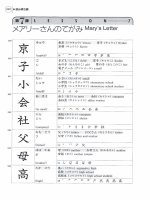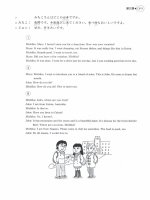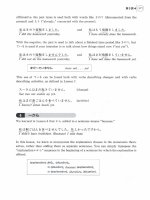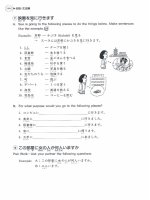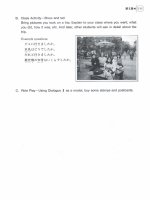genki 1 an integrated course in elementary japanese1 phần 4 pdf
Bạn đang xem bản rút gọn của tài liệu. Xem và tải ngay bản đầy đủ của tài liệu tại đây (4.32 MB, 33 trang )
There's
a%
inte~tional
student
oaer
there
Thwe
&/are .
.
.
person
fig
Ll
ZT
I
We
learned
in
Lesson
2
that'
to
ask
for
the
location
of
item
X,
you
can
use
the
word
Z+Z
(where)
and
say
X
td
Z*
Z
Trtf
hh.
Where's
McDonald's?
In
response,
one
can,
of
course, point
and
say:
i6.F:
t
over
there.
-7
7
Cj-
IL
Y
la
{
]
MrDonoM9s
is
right
ihwg
near
you-
L
L
right
hen?.
In
this
lesson,
we
will
learn
to
describe
locations
in
more
detail.
More specifically,
we
learn
to
describe
the
location
of
an
item
relative
to
another
item,
as
in
"X
is
in
front
of
Y."
The
Japanese
version
looks
like
X
12
Y
@MITT.
dl
(77
F~-ILF~~)
&QH*I~-
b
a%-cT0
a
a
It's
ifi
frolzf
of
that
department
store-
Other
useful
words
describing
locations
are
as
follows:
location
words
XktY03<
+
Y.
Xis
X
is
betwgn
Y
u~d
2.
-
fo
the
right
of
-
to
the
left
of
k
frmi!
of
behid
inside
onlabone
~derl
beneath
near
next
to
X
I2
Y
&
Z
DSLlETT,
-
as
'
Ut-2
!3
3%
5L5
&h'
5%
Clk
51%~
em5
TZl-0
sm3@@%?a
z
a
9
TT0
3A:i
rL~d-X.
The
baxk
is
next
to
the
library.
3
E3
T
-
7*1b
@TTT,
L
f:
The
umbrella
is
under
the
table.
LX
b
7
>t2Tt/'-
j,
Z%EaaTTD
Cf~ir.X,
fit,,?
The
restaarant
is
betwez
the
department
store?
and
the
hospital.
One
can
use
any
of
the
above
location
words
together
with
a
verb
to
describe
an
event
that
occurs
in
the
place.
To
use
these
phrases
with
verbs
such
as
&-f
6
and
EFg,
one
will
need
f:
f
the
particle
T.
$~ia~\-/i";.9*>;1~7um-c%
7
-3
ke%G
2
Lfzo
hkL
3
i-
3
1
waited
for
Mary
in
fymt
of
fhe
ffgag~n-Dms
phce.
The
past
tense
foms
of
verbs
look
like
the
following,
where
stands
for
the
stem
of
a
verb.
affirmative
negative
present
tense
-3s
-2Wh
1
past
tense
%tk
I
did
wo2-
stvdy
Jzpanese yesterday.
The
various
details
of
formation
of
the
long
forms
that
we
Iearned
in
Lesson
3,
like
the
rol-verblu-verblirregular
verb
distinctions,
all
apply
to
the
past
tense
fonns
as
well.
4
Another
word
for
"near"
that
is
also
commonly
used
is
t;
ZY
<
.
*3oth
X
XY
~9
Z
fb
1)
T$
and
X
MY
0
k
L
TT
describe
situations
where
two
items
(X
and
Y)
are
found
side
by
side.
For
a
Y
Q
9
sentence
to
be
considered
appropriate,
items
X
and
Y
need
to
belong
to
the
same
category;
two
people,
two
buildings,
and
so
forth.
In
contrast,
an
item
can
be
1
E.
in
relation to
another
item
even
if
they
are
quite
distinct.
0
%
%
f;ra
k
4
L
nkLT3,
The
tekphone
is
by
the
restrom
x'd31at.r
V~L:Q~T+,
(odd)
7-X.
h
The
past
tense
versions
of
"X
CI
Y
TT"
sentences
look
like
the following.
affirmative
negative
present
tense
-73
GSZE!~~@~
past
tense
-TLk
~+&!9$t%~tk~
LT*&~3*BA*a*3TLf *
+3
Lfi+b,LYt*
Y
%<
BC(
Xsx
IMP:
Yamtzshzta
was.
a
studmf
at Tozai
U~iversify.
atj#-~E;;ta~a@EL"e&
I)
aexl-cL7"r.
i:
IXX.
;ti'
d'
That
was
not
a
Japanese
movie-
Bxgmssion~
of
quantity
in
Japanme
me
rather
different
hm
those
in
English.
In
Jmanesb
if
mu
want
to
add
a
quantity
word
like
1":
i
3
to
the
direct
object
of
a
serrtmce,
rau
ean
either
pHce
it
befare
the
noun,
or
after
the
particle
2.
F32t:
{
$At3S@T
L*L&
$$%
3
2
L
f;,
I
took
maxy
pictures
i~
Kyoto.
b*L
323
z
f:
<
SAFS&
L+L/"
The
duration
of
an
activity
is
expressed
with
a
bare
noun,
like
-*
P4.
Such
a
noun
stands
U
5L.
alone
(that
is,
not
followed
by
any
particle)
and
usually
appears
immediately
before
the
verb.
%r1~-"r~ia+r~tzi~tsx/e-er~~~~a
tk,
r~b
L'
h-/,
I
Mary
waited
for
Takeski
there
for
an
hoar.
For
an
approximate
measurement,
you
can
add
(.
h
x7
after
-eC
hB.
C
6&
'As
was
the
case
with
the
present
tense
L'
s
&
1
3
%?A,
written
language
would
more
likely
have
TC;t
$5
'I
3*htLf=,
insteadofthecontractedfom
L'rh
!!3+ktLTLf=.
7
As
we
learned
in
Lesson
3,
for
"at
about
a
certain
time"
we
have
another
word
z'&.
?At23~,
j
a+s$E*ila7
C
~LY&%L~
Lf:,
hf-L
I:
IIL?
>X.
L.
d-,"
-;LW
I
studied
Japa~ese
for
about
three hours
yesterday-
1
speak
Japanese
d
English.
1
went
to
Kyoto
g&
Osaka.
The
other
meaning
of
Z
is
"together
with";
it
describes
with
whom
you
do
something.'
%7'J-3X/E32-2&Y@~l=fi,3.aT,
-4-k:
<
I*
Mary
will
go
to
Korea
with
Sue.
We
learned
in
Lesson
2
that
we
use
the
particle
%
in
reference
to
the
second
item
which
shares
a
common
attribute
with
the
first.
You
can
also
use
$
when
two
or
more
people
perform
the
same
activity.
I
wmt
fo
Kyoto
yesterday.
%
*
%
3
c3
3
3%
i=?f
3
3
t
7"z,
Pmfesso~
Yamashifa
wmt
to
Kyoto
PA
L
k+?&+i~>-
I.+?
Z
r*
yesferday,
too.
Or
when
someone
buys,
sees,
or
eats
two
or
more
things.
Mary
bogghf
shoes.
Mary
bought
a
bag,
too-
In
both
cases,
t
directly
marks
an
item
on
the
list
of
things
or
people
that
have
something
in
common.
Observe
that
$
replaces
the particles
12,
dr,
or
2
in
these
sentences.
You
can
also
use
t
when
you
go to
two
places,
do
something
on
two
different
occasions,
and
so
forth.
8~ou
can
use
Z
to
connect
nouns
only.
We
will
learn
about
connecting verbs
and
sentences
in
Lesson
6.
'"With"
as
in
"with
chopsticks"
requires
another
particle.
See
Lesson
10.
1
went
to
Kyoto
last week.
1
wmt
to
Osaka,
too.
ups-
5
3
hld&%E3
E=rP 74
t=$f?
3
Lfzo
fki
V
I
i
Robert
went
to
a
party
on
Saturday.
H%HI.~trf-?d
t~$733
Lfzo
ftGli
if
L
,
He
went
fu
a
party
on
Sunday,
foo.
We
put
$
after
the
particle
t=
in
these
sentences.
More
generally,
particles
other
than
d2,
55
and
??
are
used
together
with
&,
rather
than
being
replaced
by
it.
Expression
Notes@
.
.
X
X
is
often
used
in
the sense
of
"across
(the street)
from
X"
or
I
bx
"opposite
X."
You
may
also
hear
another
word
that
is
used
in
the
sense
of
across,
namely,
X
8
Q
fiht1.
If
something
is b&ind
X,
or
farther
away
from
a
street
and
cannot
be
directly
seen
because
of
the
intervening
X,
in
addition to
calling
it
X
OB
5,
J
L
you
can
also
describe
it
as
being
X
a)
5
5.
3
/&
3
)
In
the
dialogues,
we
observe
Mary's
host
father
saying
L
3,
and
her
host
mother
saying
21
3.
k
3
is
like
the incredulous "what?"
that
you
use
when
you
have
heard
something
that
is
hard
to
believe.
3
is
used
when
you
have
suddenly
noticed
or
remembered
something.
The
small
-;,
at
the
end
of
these
littIe
words
indicates
that
these
words,
when
pronounced,
are
very
short.
=eB*
b
%
(half)
appears
after
the
unit
word
like
@E.
Thus,
''two
hours
1Z
LfJhElu
@A2
E
*A
and
a
half"
is
X@Bi+
rather
than
I+U3Bi.
C
C
*,%l2b9
I;
CtA
C
%
b%
b
b
&
t
b
L
is
"hello,"
which
is
used
only
in
telephone
conversa-
tions.
Some
people
use
&
t
%
L
when
they
place
a
calI.
Some
other
people
use
it
when they
receive
a
call.
1
Practice
nh,
L93
(T'A$2~&
'Ll'
9
ELI
iY<
A.
Look
at
the
picture
and
tell
what
you
see,
using
&Dbt
or
Llbb.
B.
Answer
the
following
questions.
1.
&Q~=~~&zI~+@LZ
1.3
2h2&
1
3
T*'O
2
6
1:
[i,L
2.
A
Pd:tz@%i=$3$f~\3
%&',
rtx
43:
3.
;fiQka~sIz~lsrh
3
3T&xo
Wg:
i
&i:
4.
$,
QfLul+&t~
E~+XC~F**~L~~
?hx,
3
I:
l3itU/v
5'(
ttL'
5.
7~\"-
icR;trr;til
3
3
p-**,
kll
6.
t
c3&Z
(classroom)
GI
t:&L?)'l\
2
?$lo
3i3
LT
7.
@%El
(zoo)
I=+T$Qc\3
Thao
r3
;:-LA
01:
8.
&QkaB
(country)
t-R&'i&,
9
3
Thh0
<
t=
kt:
9.
25
Qft
o?gt=m75r&
3
3
-?a>,
r>;i
Qr:
C.
Look
at
Takeshi's
schedule
for
the
week
and
answer
the following
questions.
@
club
activity
5'
-3
7"
party
~f-?
4
-
test
FX
b
D.
Pair
Work-Write
down
your
next
week's
schedule
and
ask each
other what
plans
you
have
on
each
day
of
the
week.
Example:
A
:
AqE3
Ccflh:&
9
a-j-h.,
,
j
><
,
'
-
-
Your
Schedule
Your
Partner's
Schedule
o
mr~igez~m
&
La
hX/v
A.
Look
at
the
picture
and
tell
where
the
following things
are.
@
Example:
E
L
r
h.l,
+
negt2kT
y
i
*.A
7:t
,fi:<
tl
L
r
Look
at
the
picture
Example:
+
IfX.
2.
7
9
.;r
b
(racket)
and
tell
where
the
following
things
are.
@
C.
Pair
Work-Ask
and
answer
questions
to
find where
the
buildings
are.
One
student
looks
at
map
A.
The
other
student
looks
at
map
B
(p.
93).
Don't
look
at
the
other's
map.
Example:
A
:
%El
t3
L
TT$h,
z
3
i5&
-%.
B
:
*H~~,-~;TIL@z
~ii~.
fa
9
T?,
Ask
where
places
are.
the
following
A.
Look
at
the
information
about
Prof.
Yamashita
25
years
ago
and
answer
the
questions.
@
Twenty-five
years
ago,
Prof.
Yamashita
was
twenty-two
years
old
senior
at
a
college
good
student
his
major-Japanese
history
Example:
Q
:
T
%*
Gd
A**
(college
student)
T
L
T:
$a,
99
Lf:Q/v-tC~\
f:~bhr{etx
B.
Pair
Work-Guessing
game
Ask
questions
and
find
out
the
prices
your
partner
has
chosen.
i
I.
Before
you
start,
both
of
you
will
choose
one
price
in
each
row
of
the
table
and
mark
it.
i
2.
In
each
row,
use
the
item
and
one
of
the
four
prices,
make
a
yes-or-no-question
sentence
and
find
out
which
price
your
partner has
chosen.
i
3.
You
can
ask
at
most
two
questions
with
one
item.
If
you
have
guessed
col-rectly
the
price
your
partner
has
chosen,
you
score
a
point.
Your
partner
i
will
not
give
away
the
right
answer
when
you
ask
a
wrong
question.
i
4.
When
you
have asked
questions about
all
the
items
in
the
table,
switch
roles
i
with
your
partner and
answer
their questions,
i
5.
Tabulate
the
score.
You
win
the
game
if
you
have
scored
higher
than
your
partner.
Example:
A
:
h~7511%tL1~~5pJTL?:&',
::
ZLXL
B
:
LlL\L,
-3flU+&r)
3~tLTLfz,
::
*XI,4,
A
:
ZH-FqTLfz&',
L>t,$A
:-
B:
idkh.
%?TTo
C.
Pair
Work-Suppose
you
got
one
thing
as
a
birthday
present
and
choose
it
from
the
items
on
the
next
page.
Your
partner
guesses
what
you got.
Answer
your
partner's
questions.
Example:
B
:
7°t-k?2
bt$-hhlbh-il-Lkha,
A
:
22,
&llfATLft,
L\L\R,
hxt%X.
C
+
&
3
2
L
Lo
Qaaelrmzb%
bt=fix
[f3&3ZF
t6T
A.
Change
the
following
verbs
into
-3
L,k
and
bI2hFL.k
Example:
fz
"=
&
+
f=
4
2
?Z
?=".=.&
+
w2ea-c+/vfz
1.
~3Q-j-
2.6a-5
3.
ab;
4
5.
(6
6.
33
7.
g$&
8.
hh'6
9-33
10.1:&
11.Wb
12.la6
1
14.hxL;5
15.Qlb;
B.
The
pictures
below
show
what
Mary
did
last
week.
Tell
what
she
did.
@
Example:
$7')
-$/v~dfiQ~
1=flg%t%S$L3
Lf=o
7
3
w
r
L
b
d.X.
<A315
Ex.
Monday
(I)
Tuesday
12)
Wednesday
(3)
Thursday
in
the
library
(4)
Friday
at
home
(5)
Saturday
at
a
coffee
shop
(6)
Sunday
at
a
department
store
at
a
friend's
house
in
Kyoto
C.
Look
at
the
pictures
in
6
and
answer
the
questions.
@
D.
Look
at
the
pictures
above
and
answer
the
questions.
@
Example:
Q
:
$7')
-3hi3fi%El
~c@J??
L3
Lfzhx,
If713
W
24:
A
:
~~~'I"~~
L
2
t
*to
I:
LA
h.rL
*&Lbi
1.
$7
3ttl27k%~3
ttH&
L
3
Lf=ah,
Ttbli
V'
Qit
2-
%
7')
3X/EAA%l3
I=@$
L3
Lt=&*o
d.+i
U:
01:
3.
$711
-s~,ta~h9vt~g4.~,3
t)~th>,
<L\
~
X
4.
%71) 3h/t2~\9R~\4@2
t3
L?:hXo
6.
he,
5.
$7
'1
-$X,i$&qm
~cZ"~T~RZ*~.J~L~B~~
Lf=dao
3bli
V
1IX,
f:
E.
Pair
Work-Ask
what
your
partner
did
on
Monday,
Tuesday,
etc.
Example:
A
:
a%B
t=R&
L
3
LL=hh,
7
V
rlr:
B
:~.=.xetaL~~~
Pair
Work-Using
the
expressions
below,
ask
your
partners
how
often
they
did
the
following
activities
when
they
were
a
child
or
in
high
school.
Example:
A
:
3j%~%/SEn+
L
{
*$?%A
3
L
f~i~a~
Y
3
:-I
r3
iiit
a
A.
Compare
sentences
(a)
and
(b),
and
change
sentence
(bj
using
5.
Example:
(a)
~\~/T-#-t;f:=T5RT~,
1:
hk+<%&
(b)3-k-13=BP3TTo
+
x-k-&=XaTTo
1:
Vy42L
I:
i"~<i/~
1.
(a)
tzC-fL3X,t;j;%$l-t2R~\3
Leo
L
ITlr
fi.
(b)
f.1f
L
$hIih11Tk2E~\3
L?:";.
d.
2-
(a)
GYP-
b
3X,1J134+32%f&L3TO
:
3
<A,$ij
(b)
%P'I-Sk1dfl$-Z2%%L3T0
1:
Ilk
:
<&>l+
3.
(a)
t=
13
L
3
&X/lazk%
El
t:
7rt~i.i
b
2
L
3
"g-,
Z'
L
5
V'
4.
(a)
Ir7'1-3At33
$iTEI~Si23L2T0
1:1zX,:
122-
(b)
%7ll
-3AiiF%TB*%23L2fo
2's
:
i
i:
1iX
:.
:ic
5.
(a)
&L7"z,
%7'r)
3X/tif-=1~L3kt~+~~~~,
A
(b)
LLz.
97'1
-3L,iax-sx,i~4~\~~,
h
6-
(a)
%a,
LL
414T3
$-+?AT
L
f:,
*,LLq,-j
IrtllL.
i,
(b)
3033.
LL
k:E3a*x/TLfi0
XIL.LIL
,
,
B.
Describe
the
pictures
using
6.
@
Example:
&*%X/liF%T7fo
-?*&ti
d<<
+fL*
m+
2
tL
t
%&TTo
k
Q*
d'(
yb.
student
go
to
a
party
(5)
@)
&@Cl@g
(Review
Exercises)
hhr
Lw5
A. Answer
the
following
questions.
B.
Pair
Work-A
and
B
want
to
play
basketball
together.
The
following
is
A's
schedule
for
this
week.
(6's
schedule
is
on
p.
93.)
Play
the
roles
of
A
and
B
with
your
partner.
Ask
each
other
what
the
other
is
doing
and
decide
on
what
day
you
will
play
basketball.
Example:
A's
Schedule
Pair
Work
@
C.
Map
8
Ask
where
places
are.
the
following
Pair
work
@
B.
Example:
B's
Schedule
Months
b\ch29
(-8)
January
L
%75;3
(-Ira)
July
C~h'7
(=A)
February
Id
G
&:-
(~k
fi
)
August
3hhi'7
(~fi)
March
(
7Sf9
(ha)
September
LhZ7
(mj)
April
C
q~
j
hp9
(f-fi)dctober
:fit9
(&A>
May
@
j
L
$,
$29
(+
1
)-November
6
<
h29
(*I>
June
U
@
i
6~75~3
(-+s
fi
)-December
Time
Words
Day
Week
Month
Year
i2X
ZL~
+th@&b?
Ct754f9
3
2
$a?X
(%Q
a)
(=-baEI
8)
the
day
before
yesterday
the
week
before
last
the
month
before
last
the
year
before
last
3~13
(wa)
Ie~~rpj
(%a)
-tfhIf-;,(%fl)
314%L(isF)
yesterday
last
week
last
month
last
year
'13
(+a)
~/,~ni
(+S)
.
r&tr7(+fl)
tZL
(WF)
I
today
I
this
week
this
month
I
this
year
I
~,\.\~rp
9
(%a)
~-,L\I-~T
(iffa)
~L'~X.(~PSF)
tomorrow
next
week next
month
next
vear
h37-C
31;~\t~p5
3
~df-3
5
L;
~hjfah
(%*a)
(.$%a)
(&*+)
the
day
after
tomorrow
the
week
after
next
the
month
after
next
the
year
after
next
'cp$%fiR?J
/
A
Trip
to
Okinawa
@
Robert
and
Ken
are
vacationing
in
Okinawa.
@
At
the
post
office.
@
On
Monday
at
school.
Robert:
Nice
weather.
Ken:
Yes.
But
it
is
a
Little
hot.
Robert:
Wow, beautiful
sea!
Ken:
Let's
swim.
*
*
*
Ken:
What
kind
of
sports
da
you
like,
Robert?
Robert:
I
Iike
surfing.
Shall
we
do
it
together
tomorrow?
Ken:
But
isn't it difficult?
Robert:
No.
Robert:
Excuse
me.
How
much
is
a
postcard
to
Britain?
Person
at
the
post
office:
70
yen.
Robert:
Then,
two
70-yen
stamps,
pIease.
And
one
SO-yen
stamp,
please.
Takeshi:
Robert,
thank
you
for
the
postcard.
Did
you
enjoy.the
trip?
Robert:
Yes.
The
sea
was
very
beautiful
in
Okinawa.
Takeski:
Good.
I
like
the
sea
very
much,
too.
Was
the
airline
ticket
expensive?
Robert:
No,
it
wasn't
so
expensive. How
was
your
date,
Takeshi?
Takeshi:
.
.
.
sea
postal
stamps
ticket
surfing
homework
food
birthday
test
weather
drink
postcard
bus
airplane
room
I
(used
by
men)
holiday;
day
off;
absence
travel
new
hot
(weather)
hot
(objects)
busy
(people/days)
large
interesting
frightening
cold
(weather-not
used
for
objects)
fun
small
boring
old
(thing-not
used
for
people)
*
Words
that
appear
in
the
dialogue
easy
(problem);
kind
(person)
$
L
inexpensive;
cheap
(thing)
disgusted
with;
to
dislike
(-&<)
beautiful;
clean
healthy;
energetic
quiet
fond
of;
to
like
(-5')
to
hate
very
fond
of;
to
love
lively
handsome
not
busy;
to
have
a
lot
of
free
time
to
swim
toask
(person
G-)
to
ride;
to
board
(
1:)
to
do;
to
perform
(-
2
to
go
out
Adverbs
and
Other
Expressions
*
Lhq
L
k
tC
4%
EZ
together
*
-?hfiab
and
then
fz~hr
a
9
*.i:
It's
okay.;
Not
to
worry.;
Everything
is
under
control.
very
what
kind
of
.
.
.
[counter
for
flat
obi
ectsl
to
((a
place);
as
far
as
(a
place);
(a
time)
There
are
two
types
of
adjectives
in
Japanese.
One
type
is
called
"
kl-adjectives,"
and
the
other
type
"
3
-adjectives,"
L
\
and
fa'
are
their
last
syllables
when
they
modify
nouns.
3
,
S
L
6
1
2
E
3
L
.
1
saw
an
interesting
mode
yesterday.
21
*
k
Z
b
L
5k
?k
a
scary
teacher
Y&PI\
A
T
% 3
Z
b
%
T
Professor
Yamaskita
is
a
sea0
teacher.
+i
Lf:+?&ttl.
tfX*QLt
1
fi
b
2
TJ&
a
beautiful
pictgre
LrLL
I
took
a
beautifa2
picture
in
Kyoto.
Z
%
an
energetic
teacher
If/.,
I
+f/vQ~~
7;
%
5
12
X
%
;Pd
3k
&
T
To
Professor
Yamaskita
ii
energetic
teacher.
C3
Lf:+?L+?i>
If&
3
.ttA,Qzr
Japanese
adjectives
conjugate
for
tense
(present
and
past),
polarity
(affirmative
and
negative),
and
so
forth,
just
as
verbs
do.
The
two
types
of
adjectives
follow
different
conjugation
patterns.
LI-adjectives
&\-adjectives
change
shape
as
follows.
You
wiII
want
to
be
very
careful
here,
because
the
pattern
is
rather
complicated.
S%b3L\
aff
ir
rnative
negative
present
8%
b3L+lT$
S%t5<&9dt?h,
It
ik
interesting-
It
is
~ot
interesting.
past
It
was
interesti7ag.
If
was
not
interesting.
It
is
interesting
(and
confusing)
that
the
idea
of
past tense
is
encoded differently
in
the
affirmative
and
the
negative
polarities:
(
iG
%
L
3)
hi
9
f=
TT
is
"past
+
af
firnative,
"
while
(i5
%
t
4)
{
&I
9
2
#A
T*L
R
is
"negative+past.l"
Unlike
verbs,
adjectives
conjugate
fairly
regularly.
The
only
irregularity
worth
noticing
at
this
stage
is
the
behavior
of
the
adjective
k\L\
(good).
The
first
syllable
of
t>Ll
is
changed
to
1
in
all
forms
except
the
dictionary
form
and
the
long present
tense
affinna-
tive
form.'
L\L\
(irregular)
affirmative
negative
present
LILITT
&<&!I%eh,
past
&;b\=)ftTT
-
d;<bSm32hrTL,k
a-adjectives
The
conjugation
pattern
of
3-adjectives
is
much
more
straightforward.
It
actually
is
exactly
the
same
as
the
conjugation
table
of
TT
which
follows
a
noun,
as
discussed
in
Lesson
4.'
Zsi
(a)
affirmative
negative
fflu
b
present
ZSTT
ffhb-
ESiLaS!I3tZtv
Mlu
+!
She
is
healthy.
She
is
not
healfhy.
past
TI;%TI/f=
wfu
d-
n;ZE*;fS93tZhTLk
Wfu
3
She
was
healthy.
She
was
not
healthy.
The
final
syllable
3
is
dropped
in
these
long
forms
of
3-adjectives.
'Some
speakers
follow
a
more
regular
conjugation,
where
C-if'
is
inert
in
both
polarities.
For
these
speakers,
the
chart
looks
like
the
following:
,;
I
31:rj
affimative
negative
-
%
present
-b
xTT
-{
2blT-T
past
T
{;'dh's,IF:T$
'There
actually
are
alternate
forms,
I
r\
and
d:
hT+,
but
they
are
much
less
frequently
used
than
L\Lx
and
~1klT'f'-
'As
with
tl-adjectives,
some
speakers
prefer
an
alternative
para-,
such
as
the
foIlowing:
affirmative
negative
present
-T$
U.rQb\f"g-
past
-TI-
i?:
t'~fb&*~f:T-$
In
this
lesson,
we
learn
two
Q-adjectives
that
am
very
important
from
the
grammatical
point
of
view.
They
are
%I-
$
(
Q)
(to
be
fond
of;
to
like),
and
3
4
L
1
f
3
a')
(to
be
disgusted
f
with;
to
dislike).
The
meaning
of
these
adjectives
is
relational,
and
you
need
two
terms:
a
persow
like
or
dislike
something
on
the
one
hand,
and
a
person
or
a
thing
on
the
other
hand
that
is
liked
or
disliked.
In
sentences,
these
two
terms
usually
appear
with
the
particles
43
and
fif
,
respectively.'
The
item
that
is
liked
or
disliked
can
also
be
a
person.
You
may
want
b
be
cautious
using
these
words
in reference
to
your
preference
for
a
specific
person,
Lowever,
because
7
3
TT
is
usually
taken
to
be
an
admission
of
one's
romantic
interest.5
Let
us
note
three
more
things
about
3r5
3
(
G)
and
3
h
L
(
3
)
before
we
go
on.
One,
if
you
T
like
or
dislike
something
(or
somebody)
very
much,
you
can
use
the
intensified
forms
of
33
3
TP
and
3
b
L
\T$,
namely,
A%
3
TT
and
A
3
h
6
\
TT.
These
forms
are
more
T
t
f:L>
common
than
the
combinations
of
Ef
3
(
fd:
)
and
3
b
r
(
)
and
the
degree
modifier
%+
Z
T
$,
to
which
we
wiIl
turn
shortly.
Two,
when
Japanese
people
want
to
say
that
they
neither
like
nor
dislike
something,
they
usually
say:
I
fieither
like nor
dislike
(it).
Three,
you
can
use
H
3
I'd:
and
3
L;
L\
Q
as
modifiers
of
nouns.
For
example,
you
can
say
f
things
like:
41n
contexts
where
you
are
contrasting
two
or
more
items,
the
particle
CA
is
used
instead
of
$5
Thus,
3 3
3
.
I
3
h
To
1
like
vegetables,
but
I
don't
like
meat.
5
r+r t
,:
<
In
the
expression
of
romant~c
or
familial
affection,
the
complex
particle
a)
Z
Z
75.'
can
replace
2'.
Thus,
~s~ra%~y 4~a~
t$hse~tS.
=%7l1-5ttd:3?1TTO
-f
-i
Takeshi
is
in
Zooe
with
Mary.



